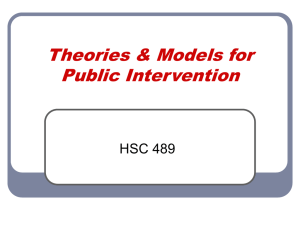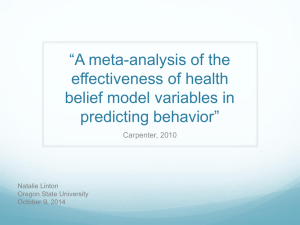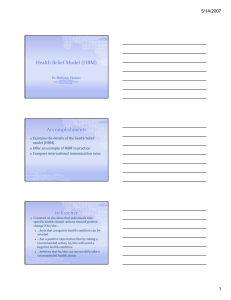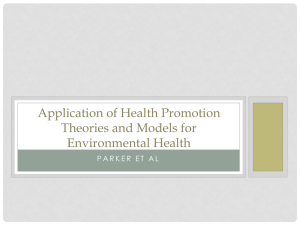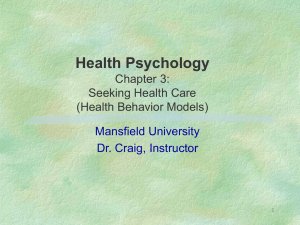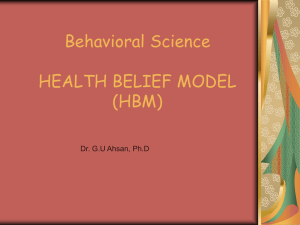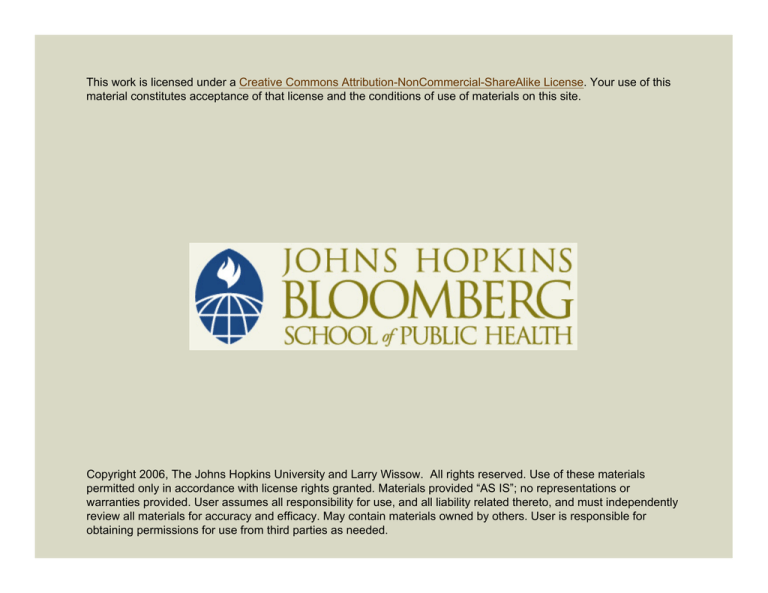
This work is licensed under a Creative Commons Attribution-NonCommercial-ShareAlike License. Your use of this
material constitutes acceptance of that license and the conditions of use of materials on this site.
Copyright 2006, The Johns Hopkins University and Larry Wissow. All rights reserved. Use of these materials
permitted only in accordance with license rights granted. Materials provided “AS IS”; no representations or
warranties provided. User assumes all responsibility for use, and all liability related thereto, and must independently
review all materials for accuracy and efficacy. May contain materials owned by others. User is responsible for
obtaining permissions for use from third parties as needed.
Changing People’s Behavior
Larry Wissow
Professor
Health, Behavior and Society
Johns Hopkins School of Public Health
Changing people’s behavior
Review of approaches to behavior change
The “transtheoretical model” as a unifying
hypothesis
“Motivational interviewing” as a clinical
application of the TTM
Major public health campaigns
Stop:
Smoking
Drinking excessively
Eating unhealthy foods
Having unsafe sex
Over-consuming resources
Behaving violently
Major public health campaigns
Start or continue:
Exercise more
Shift diet to more fruits and vegetables
Use condoms
Use seat belts
Conserve water and energy
Attempt early detection of potentially serious
illnesses
A mixed record
Some successes
Smoke detectors
Seat belts and air bags
Cigarette smoking
Less or no success
Violent behavior
Substance use
Energy conservation
“Truths” about behavior
change
Change is difficult
Our brains are wired to preserve behaviors that
have been learned
Family members and others in the social
environment are powerful forces
Many structural features of the environment
promote behaviors that we wish to initiate or
stop
Example of food
Conditioned responses related to eating very
hard to extinguish
Eating is a social activity that usually takes
place in the company of others
The environment has a huge influence on
what we eat
Take a moment to reflect on
changes we have tried to
make and what contributed to
success or failure (personal or
directed toward others)
Health Belief Model
at this point one of most widely used theories
of health behavior change
developed in 1950’s by USPHS to try to
understand why people would not participate
in preventive health campaigns (TB
screening)
Health Belief Model
based on “value expectancy theory” – people
act based on their reckoning of the value to
them of acting
a combination of behaviorism (do things that
are reinforced) and cognition (act on our
perceptions and expectations)
Hochbaum 1958 data on TB
screening
1. Perceived susceptibility
could you have TB even if you felt well?
2. Perceived benefits of screening
would an X-ray be able to find the TB?
would early detection and treatment make a
difference?
3. % obtaining X-ray:
if “yes” to (1) and (2) 82%
if “no” to (1) and (2) 21%
Main components of the HBM
Perceived susceptibility
try to personalize as much as possible
work on accurate perception
Perceived severity
try to make as specific and individualized as
possible
Main components of the HBM
Perceived benefits
not just the benefit but personal probability of
obtaining that benefit
with regard to the specific action that is proposed
Perceived barriers
can be psychological or material
Self-efficacy (added later)
confidence in ability to take action
may vary greatly with specific behaviors related to
a given health care goal (eg: diabetes care)
Health Belief
Model
perceived
susceptibili
ty
perceived
benefits
perceived
severity
self-efficacy
perceived
barriers
behavior
change
Points about the HBM
Simple idea that each factor acts
independently is probably wrong – sequences
seem to work better; there is an order to the
cognitive process
Eg, awareness of susceptibility may need
to come first
Salience or weight of factors varies with
setting (it’s a very general theory)
prevention: barriers>susceptibility>benefits
sick role: barriers>benefits>susceptibility
Points about the HBM
The kinds of nuances just discussed lead nicely into
the “staged” approach
The HBM sometimes seems to do better describing
current states versus predicting change
For example: describes smoking status better than
which smokers will quit
Transtheoretical model (Prochaska)
evolved out of substance treatment field;
have a party but nobody comes
meant to incorporate common elements of
many theories
more explicitly than others poses temporal
framework to evolution of intention and
changes in behavior
Major assumptions of transtheoretical
model
Change happens in stages
people can remain at any given stage
no inherent motivation to change, in fact change is
feared
Each stage has mechanisms that determine
movement
each has "decisional balance" of pros and cons
progress happens when cons decrease relative to
pros or vice versa
What makes people change - TCM
Readiness predicts success more than
resistance
knowledge, skills, motivation, support more
powerful predictors of movement than
barriers, fear
increasing pros is much more powerful
than decreasing cons
Self-efficacy is a balance of confidence and
temptation
confidence in ability to do the right thing
temptation = desire to avoid negative affect
associated with resisting wrong (go over carefully)
Need to match approach to stage
Interventions have to match the stage
don't teach an action before someone has decided
to act
Six stages (varies with
version)
1. Precontemplation
no interest in change in forseeable future (their
definition: 6 months)
"uninformed" despite exposure to risk; may be
defensive, resistant
often demoralized by prior failures
rarely move from this stage without a planned
intervention
Six stages
2. Contemplation
some degree of intention to change (within 6 months)
aware of possibilities but cons >> pros; aware that
change will cost something (effort, altered
relationships, altered meaning and values,
“temptation”)
can remain here a long time; “substitute thinking for
acting” even though may voice high levels of intent
Six stages
3. Preparation
Intend to change soon (defined as within a month)
Have a plan, have taken some action within past year
[Stage from which most action programs draw
recruits]
4. Action
Already engaged in behavioral change
Can be period of most intense effort
Usually needs to last 6 months or more to avoid
relapse
Difficulty countering expectation of quick success
Six stages
5. Maintenance
active work to prevent relapse
emotional stresses create vulnerability to relapse
for some problems/people this stage can last
indefinitely
6. Termination
behavior is solidly in place
Fishbein’s “transtheoretical”
list
Necessary and sufficient to produce behavior
Form a strong intention or make commitment
No environmental constraints
Possess skills necessary
Fishbein’s “transtheoretical
list”
Also important factors
Believe that advantages outweigh disadvantages
(positive attitude)
Normative pressure supports the behavior
Behavior seems consistent with self-image or
personal standards
Emotional reaction to behavior is positive (overall)
Feel that have skills (self-efficacy)
2-session “drinker’s checkup”based
on TTM principles
Directive-confrontive
Emphasize evidence of problem
Give direct advice
Disagree directly with minimization
State diagnosis and need to act
Supportive-reflective
Empathetic replies
Develop conversation using reflective listening
De-emphasize label; focus instead on negative
effects
Advice tailored to situation and value neutral
Miller, J Cons Clin Psychol 1993;61:455-461
Some principles of
“motivational interviewing”
Express empathy for difficulties/dilemmas
Ask permission to give information or advice
Present choices
Show curiosity rather than critique
discrepancies
“Roll” with resistance
Be tolerant and patient
Outcomes of counselling
styles
Confronting highly correlated with drinking at
one year post intervention
Challenging
Disagreeing
Head-on disputes
Incredulity
Emphasizing negative characteristics
Why is it hard for practitioners to
adopt a supportive-reflective /TTM
stance?
Giving up control
Requires trust and respect for
individuals/populations that are traditionally
not accorded trust or respect
Doesn’t grow out of Western philosophy??

